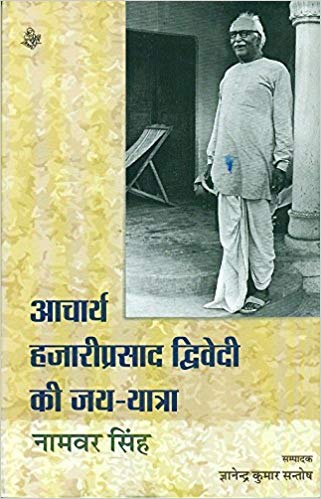This edited book is a collection of sixteen essays and speeches of Namvar Singh on his guru, the scholar and writer, Hazariprasad Dwivedi. It also contains a small separate section of references on Dwivedi that are scattered in Namvar Singh’s other writings and interviews. The book begins with the assertion that it embodies the joint wisdom of this pair of writer-critic-scholars in which each illuminates the writing of the other. Those who are already introduced to Namvar Singh’s writings on Dwivedi will not find anything significantly new. Singh’s comparatively recent lectures that have been included also rehearse themes and topics that have been explored by Singh earlier. The usefulness of the book can be found not in presentation of new material but in a fairly representative selection of Namvar Singh’s writing covering the entire range of Dwidedi’s writings from his literary essays to his novels to his academic research.
Namvar Singh places Dwivedi as a scholar in the tradition of Pandit Ramavtar Sharma, Chandradhar Sharma Guleri and Rahul Sankrityayan, great polymath and polyglot scholars with special interest and proficiency in ancient and medieval Indian culture and refuses to limit him to the list of Hindi academics and historians. The brilliance of these writers and Dwivedi is that they brought together within them the two disparate traditions of the classical and the folk. And for Namvar Singh, unless you bring these two together you are an incomplete Indian (scholar?)(p.149). Studying the folk must not be left to the anthropologist and folk studies which Dwivedi elsewhere suggests will lead to museumization of culture.
In a discourse given on the use of myths in Dwivedi’s writings (Dvivedi Sahitya Mein Mithakiya Prayog) Namvar Singh informs us that the word mithak for myth in Hindi was created by Pt. Hazariprasad Dwivedi. Dwivedi saw myths as important cultural texts to arrive at any understanding of Indian culture and in no way less important than the written texts. The centrality of myths in Dwivedi’s writings is directly linked to his concerns of the lok or the ‘folk beliefs’. He defines mithak as that which appears untrue at a distance but is found to be true upon close inspection. Myths appear illogical but have their own logic and rationale. Dwivedi has used common myths and folk beliefs to interpret many mysteries in classical literature (sastra). This use of myth pervades his entire thought process. Hence it is not only in his academic writings on classical thought and aesthetic principles that he has expounded on myths but very interestingly his literary essays on Indian culture as well as his novels contain extended play with myths and folk beliefs. So in his book on Kabir we find attempts to uncover the myth of the tortoise in the Niranjan sect through folk traditions which could not have been possible only through written treatises. There is a long episode of uncovering the origins of the name of gadahiya tal in his novel Charuchandralekha. In ‘am phir baura gaye’ (Mangoes have flowered once again). Dwivedi takes up the puzzle of mango flowers as antidote to scorpion bite. He expands upon this process of myth formation while at the same time skilfully demonstrating how the illogical can be illuminated to make sense out of seeming nonsense. How the folk helps in unpacking the mysteries of the classical. In his attempts to interpret Indian myths in an eclectic manner, Dwivedi provided Indian criticism with a completely new cultural perspective.

